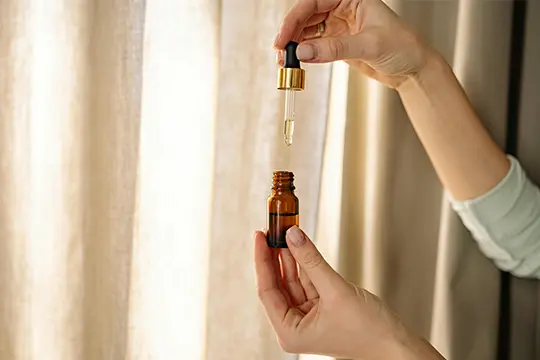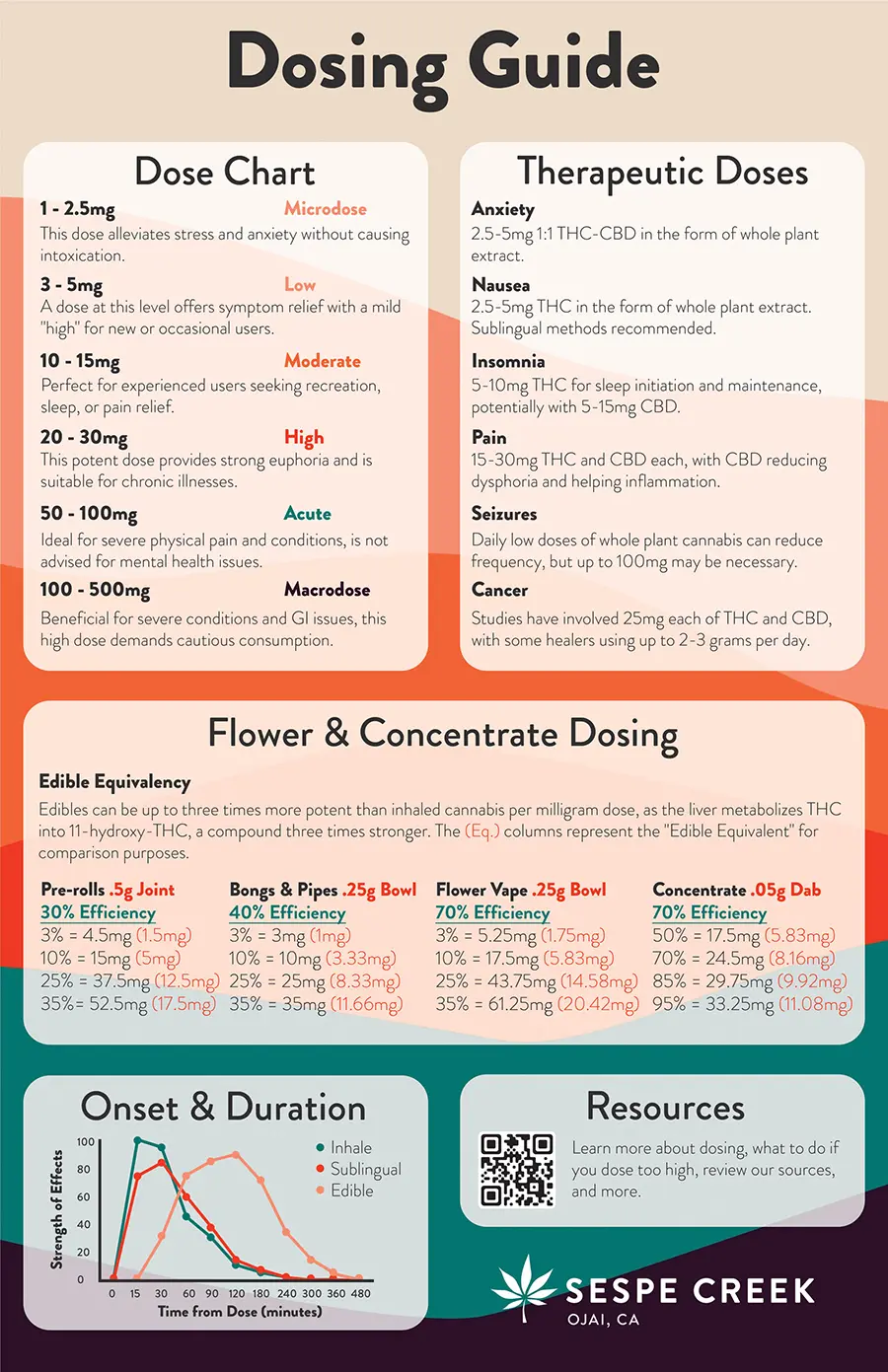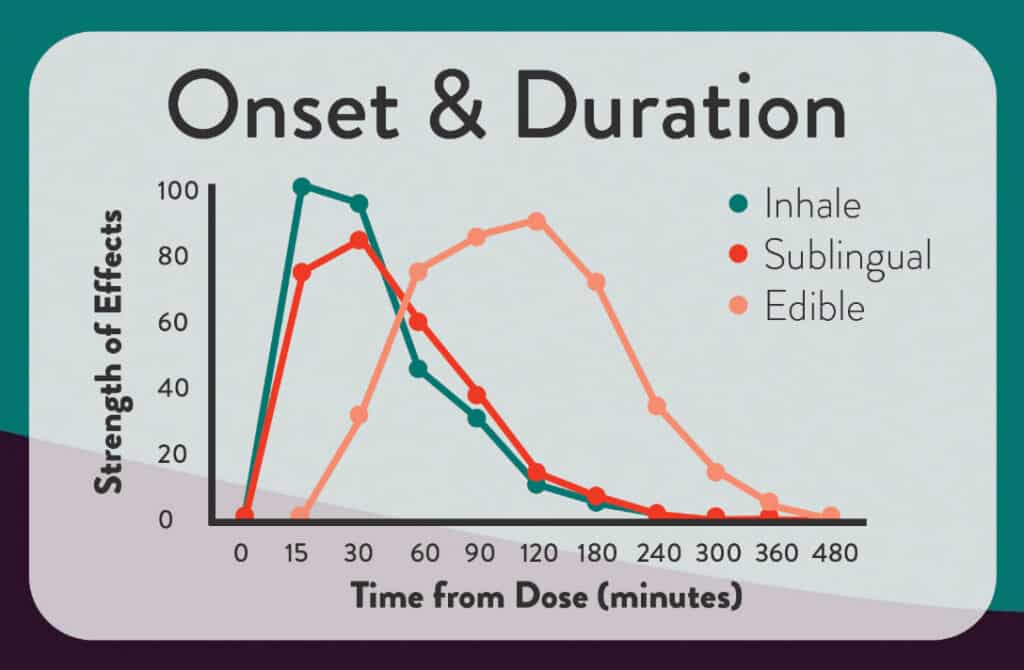
Welcome to our in-depth Cannabis Dosing Guide, a cornerstone resource aimed at demystifying the world of cannabis consumption for both newcomers and experienced users. As the popularity of cannabis for medical and recreational uses continues to grow, there remains a significant gap in understanding about the dosing process. Our guide is designed to bridge this gap, providing an easy-to-understand, practical tool that comprehensively addresses cannabis dosing.
With our guide, we take you through a journey from understanding general dosage guidelines in a simple Dose Chart, to exploring suggested Therapeutic Doses for various medical conditions. We’ll delve deeper into the nuances of Flower and Concentrate Dosing, illustrating how different methods of consumption can influence your individual experience and the onset and duration of effects. Finally, we wrap up with an FAQ section, addressing common concerns and questions, and offering insights on safe and effective consumption practices.
We want to emphasize that everyone’s experience with cannabis can vary greatly due to factors such as body chemistry, tolerance, and the method of consumption. This is why it’s generally best to start with a low dose and gradually increase as needed – a process often referred to as “start low and go slow”.
The responsible use of cannabis can be beneficial for many. With this guide, we aim to equip you with the knowledge to navigate cannabis dosing safely and effectively, ultimately enhancing your understanding and enjoyment of this remarkable plant. So, let’s dive in!
Thank you to our friend David Bearman, M.D., author of Cannabis Medicine: A Guide to the Practice of Cannabinoid Medicine for consulting us on this guide and for allowing us to source from his book.

Dosing Chart
Microdose: A Gentle Introduction to THC (1 – 2.5 mg)
Microdosing is the practice of consuming small amounts of THC, typically 1 – 2.5 mg. This is an ideal starting point for first-time consumers or those who prefer to maintain a low level of THC in their system. The primary benefits of microdosing include mild relief from symptoms like stress, and anxiety, and an enhancement in focus and creativity. The key characteristic of microdosing is that it does not typically result in intoxication, allowing users to reap the benefits of THC without the psychoactive effects.
Low Dose: The Balance Between Relief and Euphoria (3 – 5 mg)
A low dose of THC, which ranges from 3 – 5 mg, provides a stronger relief from stress and anxiety symptoms compared to microdosing. This dosage level introduces a sense of euphoria, marking the beginning of THC’s psychoactive effects. However, it may also start to impair coordination and alter perception. This dose is particularly suitable for those seeking a balance between symptom relief and a mild “high”, making it a popular choice for standard recreational use and for individuals seeking a good night’s sleep. For anxiety and nausea, 2.5-5mg of 1:1 THC-CBD whole plant extract or THC in the form of whole plant extract can be beneficial.
Moderate Dose: For the Experienced and High-Tolerance Users (10 – 15 mg)
A moderate dose of THC, between 10 – 15 mg, is a step up from the low dose and is typically preferred by experienced users. This dosage provides effective relief for symptoms such as pain, nausea, and anxiety, but it also comes with stronger psychoactive effects, including impaired coordination and altered perception. This dose is ideal for those with a higher THC tolerance, including both recreational users and medical patients. For insomnia, 5-10mg of THC for sleep initiation and maintenance, potentially with 5-15mg CBD, can be beneficial.
High Dose: Potent Relief for Chronic Illnesses (20 – 30 mg)
High doses of THC, ranging from 20 – 30 mg, are characterized by very strong euphoria and a high likelihood of impaired coordination and altered perception. This potent dose is suitable for consumers with significant THC tolerances and for patients with decreased GI absorption. The defining feature of this dosage is its suitability for managing chronic illnesses, providing strong euphoria and symptom relief. For pain management, 15-30mg of THC and CBD each, with CBD reducing dysphoria and helping inflammation, can be beneficial.
Acute Dose: For Severe Conditions and High-Tolerance Consumers (50 – 100 mg)
Very high doses of THC, between 50 – 100 mg, are a serious step up in potency. These doses can seriously impair coordination and perception and increase the possibility of adverse side effects, including nausea, anxiety, and increased heart rate. This dose is ideal for severe physical pain and conditions, but it’s not advised for mental health issues. The key users of this dosage are experienced, high-tolerance THC consumers and patients living with severe conditions such as cancer and inflammatory disorders. For seizures, daily low doses of whole plant cannabis can reduce frequency, but up to 100mg may be necessary.
Macrodose: The Upper Limit (100 – 500 mg)
Extremely high doses of THC, ranging from 100 – 500 mg, represent the upper limit of THC consumption. These doses can intensely impair coordination and perception, and increase the likelihood of unpleasant side effects including nausea, anxiety, and increased heart rate. Despite the risks, this high dose can be beneficial for severe conditions and GI issues, but it demands cautious consumption. It’s suitable for experienced, high-tolerance THC consumers and patients living with severe conditions. For cancer treatment, studies have involved 25mg each of THC and CBD, with some healers using up to 2-3 grams per day.”
Sourced from Leafly: Edible dosing for beginners which has contributions from Dr. Dustin Sulak, Anna Wilcox, Amelia Williams, and Pat Goggins
Therapeutic Doses
Anxiety
A dosage of 2.5-5mg of a 1:1 THC-CBD whole plant extract is recommended. This means that the extract contains equal parts of THC and CBD. Novice users are advised to start with a smaller dose due to the potential for THC to induce anxiety at higher levels. The CBD component, known for its calming effects, helps to mitigate the anxiety-inducing effects of THC.
Nausea
A dose of 2.5-5mg THC in the form of whole plant extract can be effective. Since THC has been found to have antiemetic properties, it may help alleviate feelings of nausea. Due to individual differences in tolerances and responses, it’s advisable to start with the lower dose and increase if necessary.
Insomnia
For sleep initiation and maintenance, a dose of 5-10mg THC, possibly along with 5-15mg CBD, is suggested. THC can promote sleep, but individual responses can vary widely. CBD may aid in reducing anxiety and promoting relaxation, which can also assist in sleep.
Pain
For pain management, 15-30mg of THC and CBD each is recommended. THC has analgesic properties, while CBD can help reduce inflammation and dysphoria (unease or dissatisfaction) that may accompany chronic pain.
Seizures
Daily low doses of whole plant cannabis may reduce seizure frequency. However, in some cases, doses up to 100mg may be necessary. The CBD in cannabis is particularly noted for its potential antiseizure properties.
Cancer
Research has involved doses of 25mg each of THC and CBD, with some healers using up to 2-3 grams per day. THC and CBD may help manage symptoms related to cancer treatment, like nausea and pain, but further research is needed.
Sourced from Cannabis Medicine: A Guide to the Practice of Cannabinoid Medicine by David Bearman, M.D. with Maria Pettinato, PhD, RN
Flower & Concentrate Dosing
Inhalation and ingestion are two primary methods of consuming cannabis, each with its own unique pharmacokinetic profile, which refers to how the body processes the consumed substance. Understanding the differences between these two methods is important for determining dosage and predicting effects.
When cannabis is inhaled (via smoking or vaporizing flower or concentrate), the active compounds, like THC, are absorbed through the lungs into the bloodstream and then travel directly to the brain. This results in a rapid onset of effects, usually within a few minutes. The peak effects are typically experienced within 30 minutes to an hour. However, the effects may be shorter-lived, often subsiding within 2-4 hours. This method allows for easy titration, or adjustment of dosage, as the effects can be felt almost immediately.
On the other hand, when cannabis is ingested as an edible, the process is more complex. In this case, the cannabis compounds are first metabolized in the stomach and then further processed in the liver. Here, the liver enzyme CYP2C9 transforms delta-9-THC (the primary psychoactive compound in cannabis) into a metabolite known as 11-hydroxy-THC.
This metabolite is particularly potent, up to three times stronger than delta-9-THC. It also has a longer half-life, meaning its effects can last much longer – often several hours or more. The onset of effects from edibles is also slower, typically taking 30 minutes to 2 hours, but sometimes even longer depending on factors such as the individual’s metabolism and whether the edible is consumed on an empty or full stomach.
However, it’s important to note that despite 11-hydroxy-THC’s increased potency, not all of the ingested THC gets converted into this metabolite. Some of it can be destroyed during digestion, and the overall efficiency of absorption is typically lower with oral consumption compared to inhalation.
In terms of dosing, this means that the same milligram dose of THC will likely have a stronger and longer-lasting effect when consumed as an edible compared to when it is inhaled. The (Eq.) columns below represent a comparative measure to help users understand how a specific dose of inhaled cannabis might translate into the potentially more potent effects of an edible dose.
Pre-rolls .5g Joint
30% Efficiency
Cannabinoid %:
3% = 4.5mg (1.5mg)
10% = 15mg (5mg)
25% = 37.5mg (12.5mg)
35%= 52.5mg (17.5mg)
Bongs & Pipes .25g Bowl
40% Efficiency
Cannabinoid %:
3% = 3mg (1mg)
10% = 10mg (3.33mg)
25% = 25mg (8.33mg)
35% = 35mg (11.66mg)
Flower Vape .25g Bowl
70% Efficiency
Cannabinoid %:
3% = 5.25mg (1.75mg)
10% = 17.5mg (5.83mg)
25% = 43.75mg (14.58mg)
35% = 61.25mg (20.42mg)
Concentrate .05g Dab
70% Efficiency
Cannabinoid %:
50% = 17.5mg (5.83mg)
70% = 24.5mg (8.16mg)
85% = 29.75mg (9.92mg)
95% = 33.25mg (11.08mg)
Because of these significant differences in how the body processes inhaled versus ingested cannabis, it’s crucial for consumers to be aware of the “start low and go slow” approach, particularly when trying edibles for the first time or switching from inhalation to ingestion. This approach allows individuals to avoid potential uncomfortable or unwanted effects that might result from consuming a larger dose than their body is prepared to handle.
Onset & Duration
The onset and duration of cannabis effects can vary greatly depending on the method of consumption. Each method of administration has a different timeline for when the effects can be felt and how long they last.

Inhalation (Smoking/Vaping)
When cannabis is inhaled, either by smoking or vaporizing, the active compounds, including THC and CBD, are rapidly absorbed by the lungs into the bloodstream and then travel directly to the brain. This results in a quick onset of effects, often within minutes. The peak effects are usually experienced within 30 minutes to an hour, and the overall effects typically subside within 2-4 hours. However, this can vary depending on the specific strain of cannabis, individual tolerance, and the amount consumed.
Sublingual (Tinctures, Lozenges, etc.)
Sublingual administration involves placing the cannabis product (such as a tincture or lozenge) under the tongue and allowing it to dissolve. The active compounds are absorbed through the mucous membranes in the mouth, bypassing the digestive system and liver metabolism, which leads to a quicker onset of effects compared to edibles. The effects can usually be felt within 15-45 minutes, with peak effects occurring around 90 minutes, and can last for 4-6 hours. However, these timelines can vary depending on the specific product, individual metabolism, and other factors.
Edibles (Food and Drink)
When cannabis is ingested in the form of edibles, it is metabolized by the stomach and then the liver, where THC is converted into 11-hydroxy-THC, a more potent compound. This process can result in a delayed onset of effects, often taking anywhere from 30 minutes to 2 hours, or even longer. Once they kick in, the effects can be quite strong and long-lasting, often for several hours or more. The peak effects are usually felt around 2-3 hours after consumption. Again, the timing can vary depending on a variety of factors, including the dose, the specific product, the individual’s metabolism, and whether the edible is consumed on an empty or full stomach.
Sourced from Acute Effects of Smoked and Vaporized Cannabis in Healthy Adults Who Infrequently Use Cannabis
FAQ
How much cannabis should I use for the first time?
If you’re new to cannabis, it’s recommended to start with a very small amount and see how your body responds before increasing the dosage. For example, if you’re smoking or vaping, take one small puff and wait for at least 10-15 minutes to gauge the effects. If you’re trying edibles, start with a dose of 2.5 to 5mg of THC. Remember that edibles can take up to 2 hours or more to take effect. Always “start low and go slow”.
Can you overdose on cannabis?
While it is extremely unlikely to have a lethal overdose from cannabis, consuming too much can lead to an uncomfortable or distressing experience known as “greening out”. Symptoms can include paranoia, anxiety, rapid heart rate, disorientation, and nausea. If you’re new to cannabis, starting with a low dose and slowly increasing it over time can help you avoid such an experience.
Cannabis is generally considered a safe substance and there are no recorded instances of fatal overdoses. Research conducted on animals has allowed scientists to estimate that the lethal dose of THC for humans would be more than 15,000 mg. This suggests that THC has a significant safety margin, as the lethal dose is 750 times higher than a standard intoxicating dose of 20 mg. It’s virtually impossible to reach this lethal dose through common methods of consumption like oral intake or inhalation. Unlike opioids, cannabis doesn’t lead to respiratory depression, largely due to the lack of cannabinoid receptor expression in the brainstem.
How can I come down if I feel too high?
If you’ve consumed too much cannabis and are feeling overly anxious or uncomfortable, there are a few things you can do to help come down:
- Try to stay calm and remember that the feelings will pass.
- Find a quiet, safe place where you can relax.
- Stay hydrated and eat light snacks if you can.
- Try to distract yourself with a calming activity, such as watching a movie or listening to music.
- Some people find that CBD or THCA can help counteract the effects of THC.
- Terpenes β-caryophyllene and limonene may help as well.
- If you continue to feel unwell, don’t hesitate to seek medical attention.
Can I mix cannabis with alcohol?
Mixing cannabis and alcohol can amplify the effects of both substances, which might lead to stronger or more unpredictable effects. This combination can cause nausea, dizziness, impaired coordination, and can increase the chances of negative outcomes like accidents or “greening out”. Additionally, alcohol can increase the absorption of THC, the psychoactive component in cannabis, potentially leading to a stronger high than intended. As a result, it’s generally advised to avoid combining the two, especially if you are new to cannabis or a novice alcohol drinker. Always prioritize safety and consume responsibly.
What is a safe amount for pets to take?
The safe amount of cannabis for pets depends on the specific cannabinoid being administered and the weight of the pet. For CBD, a starting dose of 0.5 – 5 mg per 10 pounds of body weight twice daily is recommended. For THC, the starting dose should be 0.2 – 0.6 mg per 10 pounds of body weight twice daily. In both cases, it’s advised to start with a low dose and gradually increase every 4-7 days while closely monitoring the pet for any side effects such as sedation, loss of balance, or loss of mental acuity. It’s crucial to remember that any significant side effects are unacceptable and the therapy should be discontinued immediately if any are observed. For a more detailed understanding of cannabis use in pets, you can refer to our Pets & Cannabis Guide.
